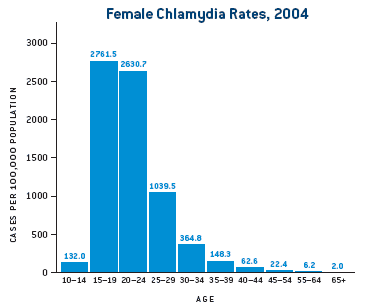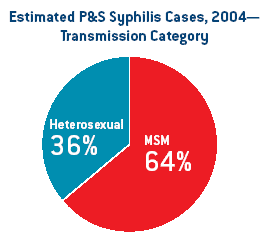Trends in Reportable Sexually Transmitted Diseases in the United States, 2004
This web page is archived for historical purposes and is no longer being updated. Newer data is available on the STD Data and Statistics page.
National Surveillance Data for Chlamydia, Gonorrhea, and Syphilis
Sexually transmitted diseases (STDs) remain a major public health challenge in the United States. While substantial progress has been made in preventing, diagnosing, and treating certain STDs in recent years, CDC estimates that 19 million new infections occur each year, almost half of them among young people ages 15 to 24.1 In addition to the physical and psychological consequences of STDs, these diseases also exact a tremendous economic toll. Direct medical costs associated with STDs in the United States are estimated at $13 billion annually.2
This document summarizes 2004 national data on trends in notifiable STDs — chlamydia, gonorrhea, and syphilis — that are published in CDC’s report, Sexually Transmitted Disease Surveillance 2004 (available at www.CDC.gov/STD/stats04/). These data, which are useful for examining overall trends and trends among populations at risk, represent only a small proportion of the true national burden of STDs. Many cases of notifiable STDs go undiagnosed, and some highly prevalent viral infections, such as human papillomavirus and genital herpes, are not reported at all.
Chlamydia: Expanded Screening Efforts Result in More Reported Cases, But Majority of Infections Remain Undiagnosed
Chlamydia remains the most commonly reported infectious disease in the United States. In 2004, 929,462 chlamydia diagnoses were reported, up from 877,478 in 2003. Even so, most chlamydia cases go undiagnosed. It is estimated that there are approximately 2.8 million new cases of chlamydia in the United States each year.1
The national rate of reported chlamydia in 2004 was 319.6 cases per 100,000 population, an increase of 5.9 percent from 2003 (301.7). The increases in reported cases and rates likely reflect the continued expansion of screening efforts and increased use of more sensitive diagnostic tests, rather than an actual increase in new infections.
Impact on Women

Women, especially young women, are hit hardest by chlamydia. Studies have found that chlamydia is more common among young women than young men, and the long-term consequences of untreated disease for women are much more severe. The chlamydia case rate for females in 2004 was 3.3 times higher than for males (485.0 vs. 147.1). However, much of this difference reflects the fact that women are far more likely to be screened than men. Females ages 15 to 19 had the highest chlamydia rate (2,761.5), followed by females ages 20 to 24 (2,630.7).
African-American women are also disproportionately impacted by chlamydia. In 2004, the rate of reported chlamydia among black females (1,722.3) was more than 7.5 times that of white females (226.6). Because case reports do not provide a complete account of the burden of disease, researchers also evaluate chlamydia prevalence in subgroups of the population to better estimate the true extent of the disease. For example, data from chlamydia screening in family planning clinics across the United States indicates that roughly 6 percent of 15- to 24-year-old females in these settings are infected.
Importance of Screening
Because chlamydia is most common among young women, CDC recommends annual chlamydia screening for sexually active women under age 26, as well as older women with risk factors such as new or multiple sex partners.5 Data from a study in a managed care setting suggest that chlamydia screening and treatment can reduce incidence of PID by over 50 percent.6 Unfortunately, many sexually active young women are not being tested for chlamydia, in part reflecting a lack of awareness among some providers and limited resources for screening.5,7 Recent research has shown that a simple change in clinical procedures — coupling chlamydia tests with routine Pap testing — can sharply increase the proportion of sexually active young women screened.8 Stepping up screening efforts is critical to preventing the serious health consequences of this infection, particularly infertility.
While screening is critical for sexually active young women, improved testing and treatment among men could help reduce transmission to women. The availability of urine tests for chlamydia may be contributing to increased detection of the disease in men, and consequently the rising rates of reported chlamydia in men in recent years (from 99.6 in 2000 to 147.1 in 2004).
Health Consequences of Chlamydia
Chlamydia is a bacterial infection that can easily be cured with antibiotics, but it is usually asymptomatic and often undiagnosed. Untreated, it can cause severe health consequences for women, including pelvic inflammatory disease (PID), ectopic pregnancy, and infertility. Up to 40 percent of females with untreated chlamydia infections develop PID, and 20 percent of those may become infertile.3 In addition, women infected with chlamydia are up to five times more likely to become infected with HIV, if exposed.4 Complications from chlamydia among men are relatively uncommon, but may include epididymitis and urethritis, which can cause pain, fever, and in rare cases, sterility.
Gonorrhea: Disease Rate Falls to Historic Low But Drug Resistance on the Rise
Gonorrhea is the second most commonly reported infectious disease in the United States, with 330,132 cases reported in 2004. From a high of 467.7 cases per 100,000 population reported in 1975, the U.S. gonorrhea rate fell to 113.5 in 2004 (a 76% decline) — the lowest recorded level since reporting began in 1941. More recently, from 2003 to 2004, the rate fell 1.5 percent (from 115.2 cases per 100,000 population to 113.5). Like chlamydia, however, gonorrhea is substantially under diagnosed and under reported, and approximately twice as many new infections are estimated to occur each year as are reported.1

Racial Disparities Persist
African Americans remain the group most heavily affected by gonorrhea. While the rate of gonorrhea among blacks fell 3.0 percent from 2003 to 2004, the reported 2004 rate per 100,000 population for blacks (629.6) was 19 times greater than for whites (33.3). In 2003, the rate for blacks was 20 times higher than the rate for whites.
American Indians/Alaska Natives had the second-highest gonorrhea rate in 2004 (117.7, up 14.8% from 2003), followed by Hispanics (71.3, up 2.3% from 2003), whites (33.3, up 2.1% from 2003), and Asians/Pacific Islanders (21.4, down 3.2% from 2003).
Ethnic minorities in the United States have traditionally had higher rates of reported gonorrhea and other STDs, in part a reflection of limited access to quality health care, poverty, and higher background prevalence of disease in these populations.
Drug Resistance Increasing In Communities Across the United States
Drug resistance is an increasingly important concern in the treatment and prevention of gonorrhea.10 CDC monitors trends in gonorrhea drug resistance through the Gonococcal Isolate Surveillance Project (GISP), which tests gonorrhea samples (“isolates”) from the first 25 men with urethral gonorrhea attending STD clinics each month in sentinel clinics across the United States (28 cities in 2004).11
Overall, 6.8 percent of gonorrhea isolates tested through GISP in 2004 demonstrated resistance to fluoroquinolones, a leading class of antibiotics used to treat the disease, compared to 4.1 percent in 2003 and 2.2 percent in 2002. Resistance is especially worrisome among men who have sex with men (MSM), where resistance was eight times higher than among heterosexuals (23.8% vs. 2.9%).
In April 2004, CDC recommended that fluoroquinolones no longer be used as treatment for gonorrhea among MSM. Fluoroquinolones are also not recommended to treat gonorrhea in anyone in California and Hawaii, where fluoroquinolone-resistant cases have been widespread for several years. Outside of these states in 2004, 17.8 percent of gonorrhea isolates among MSM were resistant to fluoroquinolones, while resistance among heterosexuals remained low at 1.3 percent.
Health Consequences of Gonorrhea
While gonorrhea is easily cured, untreated cases can lead to serious health problems. Among women, gonorrhea is a major cause of PID, which can lead to chronic pelvic pain, ectopic pregnancy, and infertility. In men, untreated gonorrhea can cause epididymitis, a painful condition of the testicles that can result in infertility. In addition, studies suggest that presence of gonorrhea infection makes an individual three to five times more likely to acquire HIV, if exposed.9
Syphilis: Cases Increase for Fourth Consecutive Year
The rate of primary and secondary (P&S) syphilis — the most infectious stages of the disease — decreased throughout the 1990s, and in 2000 reached an all-time low. However, over the past four years the syphilis rate in the United States has been increasing. Between 2003 and 2004 alone, the national P&S syphilis rate increased 8 percent, from 2.5 to 2.7 cases per 100,000 population; during this time, reported P&S cases in the United States increased from 7,177 to 7,980.
Overall, increases in P&S syphilis rates between 2000 and 2004 were observed only among men. The rate of P&S syphilis among males rose 81 percent between 2000 and 2004 (from 2.6 to 4.7), and 11.9 percent between 2003 (4.2) and 2004. Notably, in 2004 — for the first time in over 10 years — the rate among females did not decrease, remaining at 0.8. Between 2003 and 2004, the rate of congenital syphilis (i.e., transmission from mother to child) decreased 17.8 percent (from 10.7 to 8.8 per 100,000 live births), likely reflecting the substantial reduction in syphilis among women that has occurred over the past decade.

Rising Rate Driven By Cases Among Men

Increasing cases of P&S syphilis among MSM are believed to be largely responsible for the overall increases in the national syphilis rate observed since 2000. Until very recently, CDC has not collected data by risk group. However, the male-to-female ratio for P&S syphilis has risen steadily between 2000 and 2004 (from 1.5 to 5.9), suggesting increased syphilis transmission among MSM. This increase occurred among all racial and ethnic groups. Additionally, CDC estimates that MSM comprised 64 percent of P&S syphilis cases in 2004, up from 5 percent in 1999.12
Recent Declines Among African Americans Possibly Reversing
In 2004, the P&S syphilis rate among blacks increased for the first time in more than a decade — 16.9 percent from 2003 to 2004 (from 7.7 to 9.0), with the most significant increases among black men. Between 2003 and 2004, the syphilis rate among black males increased 22.6 percent (from 11.5 to 14.1), while the rate among black women rose 2.4 percent (from 4.2 to 4.3). In addition, the male-to-female ratio for blacks rose from 2.7 in 2003 to 3.3 in 2004, suggesting increases among black MSM.
Racial gaps in syphilis rates are narrowing, with rates in 2004 5.6 times higher among blacks than among whites, a substantially lower differential than in 2000, when the rate among blacks was 24 times greater than among whites. This narrowing reflects both declining disease rates among African Americans and the significant increases among white men in recent years. Continued progress in eliminating this disease will require an ongoing commitment to syphilis education, testing, and treatment in all populations affected.
Urban Areas Bear Greatest Syphilis Burden
Syphilis remains a public health problem in metropolitan areas with large populations of MSM. For the third consecutive year, San Francisco had the highest P&S rate of any U.S. city in 2004 (45.9). Other leading cities include Atlanta, Georgia (34.6); Baltimore, Maryland (33.2); New Orleans, Louisiana (16.4); St Louis, Missouri (14.1); Detroit, Michigan (13.5); Washington, D.C. (12.2); Dallas, Texas (11.6); Jersey City, New Jersey (10.8); and Chicago, Illinois (9.7).
Health Consequences of Syphilis
Syphilis, a genital ulcerative disease, is highly infectious, but easily curable in its early (primary and secondary) stages. If untreated, it can lead to serious long-term complications, including nerve, cardiovascular, and organ damage, and even death. Congenital syphilis can cause stillbirth, death soon after birth, and physical deformity and neurological complications in children who survive. Syphilis, like many other STDs, facilitates the spread of HIV, increasing transmission of the virus at least two- to five-fold.13
Cities with Highest Reported Rates of P&S Syphilis, 2004
(click map to view larger image)

References
1 Weinstock H, Berman S, Cates W. Sexually transmitted diseases among American youth: incidence and prevalence estimates, 2000. Perspectives on Sexual and Reproductive Health 2004;36(1):6-10.
2 HW Chesson, JM Blandford, TL Gift, G Tao, KL Irwin. The estimated direct medical cost of STDs among American youth, 2000. Abstract P075. 2004 National STD Prevention Conference. Philadelphia, PA. March 8-11, 2004.
3 Hillis SD and Wasserheit JN. Screening for Chlamydia — A Key to the Prevention of Pelvic Inflammatory Disease. New England Journal of Medicine 1996;334(21):1399-1401.
4 CDC. Press Release: New CDC treatment guidelines critical to preventing consequences of sexually transmitted diseases. May 9, 2002. Available at: www.cdc.gov/od/oc/media/pressrel/fs020509.htm.
5 CDC. Sexually Transmitted Disease Surveillance, 2004. Atlanta, GA: U.S. Department of Health and Human Services, September 2005.
6 Scholes D et al. Prevention of Pelvic Inflammatory Disease by Screening for Cervical Chlamydial Infection. New England Journal of Medicine 1996; 334(21):1362-1366.
7 CDC. Chlamydia screening among sexually active young female enrollees of health plans — United States, 1999 – 2001. Morbidity and Mortality Weekly Report 2004;53(42):983-985.
8 Burstein G et al. Chlamydia screening in a health plan before and after a national performance measure introduction. Obstetrics & Gynecology 2005;106(2):327-334.
9 Fleming DT and Wasserheit JN. From epidemiological synergy to public health policy and practice: the contribution of other sexually transmitted diseases to sexual transmission of HIV infection. Sexually Transmitted Infections 1999;75:3-17.
10 CDC. Increases in fluoroquinolone-resistant Neisseria gonorrhoeae among men who have sex with men — United States, 2003, and revised recommendations for gonorrhea treatment, 2004. Morbidity and Mortality Weekly Report 2004;53(16):335-338.
11 CDC. Gonococcal Isolate Surveillance Project. Available at: www.cdc.gov/std/gisp.
13 CDC. HIV Prevention Through Early Detection and Treatment of Other Sexually Transmitted Diseases — United States Recommendations of the Advisory Committee for HIV and STD Prevention. Morbidity and Mortality Weekly Report 1998; 47(RR-12):1-24.
- Page last reviewed: February 8, 2006 (archived document)
- Content source:


 ShareCompartir
ShareCompartir